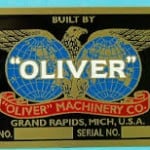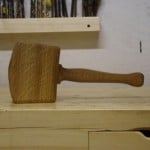Vise installation question
Welcome! / Forums / General Woodworking Discussions / Tools and Tool Maintenance/Restoration / Vise installation question
- This topic has 7 replies, 4 voices, and was last updated 9 years ago by
 chemical_cake.
chemical_cake.
-
AuthorPosts
-
I’m almost done with the construction of my bench, and after trying to restore a very old and massive unidentifiable vise that turned out to be hardly salvageable, I finally bought and almost new 9″ quick-release vise from a guy for a few bucks. It looks just like the generic eclipse or record model, but one thing I noticed and haven’t found on any picture on the internet is that the vertical face mounted on the workbench is slanted, not perpendicular to the horizontal face where the screws go. The angle is 2,75″ for 0,25″. I’ve included a picture that might explain better than I can…
My question is: how would you proceed to mounting it? My first option is to carve a diagonal recess in the apron to fit the slanted face, but this would prevent me from replacing the vise at some point, leaving me with a slanted apron…
My second option would be to screw a slanted packing between the face and the apron, which would leave the vise proud of the workbench by 7/8″.
Any advice on what’s better? Thanks!Attachments:
You must be logged in to view attached files.Also, I’m very curious about this old vise I bought some time ago. There’s “Moody” and “R-9” written on the front, but despite a long search on the internet, I didn’t find any maker of this name or even any vise that had exactly the same details. The vise was painted with a thick coat of tacky gray paint, the name barely visible, and part of the screwbox was fractured and repaired with lumps of iron. Any of you have stumbled upon the same vise? The quick-release mechanism consists of a half-threaded spring-loaded brass shoe. The brass part was shimmed with very old waxed cardboard paper as the threads seemed to have been worn down so much that they didn’t engage the screw! I decided it would be an end vise, being too risky as a main bench vise. I could upload more pictures of the disassembled mechanism if some of you are interested.
Attachments:
You must be logged in to view attached files.
Actually, I believe that some vises are purposely made that way (with the angle you mentioned) to help the vise grip even tighter at the top. I wouldn’t make modifications or allowances until you hear from other members who are more knowledgeable on the subject than I am. Best of luck!

Esquif,
At first I thought you were referring to the vice jaw toe-in where the top of the jaws close before the bottom, that’s preferred and normal.
Now I see that the rear jaw casting isn’t square.
The easiest solution is probably to plane down a”shim” to fill the void and provide support for the back casting.
Others may have a better solution.
Best,
CraigThanks Craig, that might be the best option. Assuming the shim I make is 1/8″ thick at the bottom and compensates for the angle, the vise would be proud of about an inch from the apron. Is it too much? I usually see vises proud by a half inch, or maybe 5/8″… I’m concerned leverage on the bench top would be increased, especially since the apron will occlude two screw holes from the bottom face…
 24 April 2015 at 7:12 pm #126711
24 April 2015 at 7:12 pm #126711I think I have the same vise as you; try some of the other “square” edges and you’ll probably find they’re out too.
After struggling with the same dilemma I chiselled a diagonal recess for mine, reasoning that it looked like a hefty-enough piece of kit that I wouldn’t be changing it in a hurry. If you want to fit another vise you can always shim the diagonal recess back out then to make the bearing surface flat again.
Mine has a fair amount more slop than it did when I first fitted it a couple of years ago, though still functions like a vise should. Funnily enough, I also got it for very little from a guy who never got around to fitting it. Even at new prices, and accepting it might not be as sturdy a piece of kit as the equivalent Record or whatever, it’s really phenomenal value for what you’re getting. I would take the 9″ opening and quick release function over slightly better engineering again if I had to; they are features you learn to work without if you don’t have them, but when using other people’s benches I really miss them.
Matt
Thanks Matthew! How did you proceed for the diagonal recess? I was thinking I would lay out a line at the bottom, make diagonal stop cuts, and finally chisel the waste very carefully. I think you’re right in saying this is the kind of equipment that doesn’t get changed too often, and I can even glue a piece in the recess and plane it down if I ever want another vise.
 24 April 2015 at 10:56 pm #126719
24 April 2015 at 10:56 pm #126719Exactly, you don’t want to do his job too often.
Your method sounds good.
Matt
-
AuthorPosts
- You must be logged in to reply to this topic.
